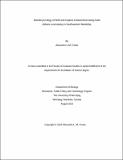Breeding Ecology of Wild and Captive-released Burrowing Owls (Athene cunicularia) in Southwestern Manitoba
Metadata
Show full item recordAuthor
Froese, Alexandra
Date
2016Citation
Froese, Alexandra. Breeding Ecology of Wild and Captive-released Burrowing Owls (Athene cunicularia) in Southwestern Manitoba; A thesis submitted to the Faculty of Graduate Studies in partial fulfillment of the requirements for the Master of Science degree, Department of Biology Bioscience, Public Policy and Technology Program, The University of Winnipeg. Winnipeg, Manitoba, Canada: University of Winnipeg, August 2016.
Abstract
Burrowing Owls (Athene cunicularia) once occupied grassland ecosystems in the western Provinces of Canada, as far east as Winnipeg, Manitoba, and west into the southern interior of British Columbia (B.C.). No single factor has been identified as causing the decline of the Burrowing Owl in Manitoba nor in Canada, however, multiple, inter-related factors are thought to be responsible for its gradual and persistent decline over the last century. These factors include habitat loss, fragmentation and degradation; considerable changes in land use practices; anthropogenic changes to the prairie ecosystem resulting in the loss of species like America bison (Bison bison), Rocky Mountain locust (Melanoplus spretus), Black-tailed prairie dog (Cynomys ludovicianus); roads and vehicular traffic contributing to increased mortality on summer, migration, and winter ranges; increased mortality and reduced nesting success from increased predation rates; and decreased prey abundance and availability that has lowered productivity and survival. Burrowing Owl population declines have been most noticeable the extremes of their range in both B.C. and Manitoba where precipitous declines have been evident over the last 50 years. Large-scale reintroductions have taken place in B.C. resulting in small numbers of released owls returning annually. Reintroductions of Burrowing Owls were also conducted in Manitoba from 1987-1996, but low overall return rates, combined with continued declines in wild populations eventually led to the program being discontinued. Few Burrowing Owls were detected in Manitoba for the next decade, but a rather sudden and unexpected return of breeding pairs was noticed after 2005 with a resurgence totaling 35 nesting pairs (cumulative total) through 2006-2009. This prompted the development of a current reintroduction and breeding ecology/diet comparison study of wild and captive-released owls in southwestern Manitoba.
In this three year (2010-2012) study, I compared post-emergence/pre-fledging foraging ecology of male adult captive-released and wild owls and related it to clutch size, hatching, and fledging success. I also collected data on adult and post-fledging mortality, burrow re-occupancy and return rates, home-range size and diet. I hypothesized that wild Burrowing Owls would have larger clutches, hatch and fledge more young, have larger home-ranges, and have more of a variety of prey items in their diet than captive-released owls. First clutches were 37% larger for wild Burrowing Owls than for released owls. Overall, wild owls raised 77% more young than captive-released owls in the first two seasons (2010-2011). Hatching success (number of eggs that hatched in each nest) was variable for captive-released owls from 22% in 2010 to 70% in 2012. Fledging success (young between 35-42 days) was 100% for both groups in all three seasons. Low adult and juvenile post-fledging mortality rates were observed with only three captive-released owl deaths recorded (3 of 47 owls). Wild and captive-released male Burrowing Owls concentrated their movements during the post-emergence/pre-fledging stage near the nest burrow and nearby favoured roosting spots (i.e., fence line posts near roadside ditches and satellite burrow mounds). Diet varied between groups in both biomass and frequency. Captive-released owl pairs had lower frequency of vertebrate prey in their pellets compared to wild owls. Even with less vertebrate remains observed in their diet, biomass percentages were similar to other studies. The greatest threat to both wild and captive-released Burrowing Owl nests during my study was extreme summer storms resulting in the flooding of nests. Eight of 23 first and replacement clutches (35%) containing 62 eggs were lost from flooding. Despite the small numbers of captive-released and wild owls that were monitored during this study in Manitoba, several results point to captive-released owls readily adapting to the wild and in many respects behaving like wild owls.

